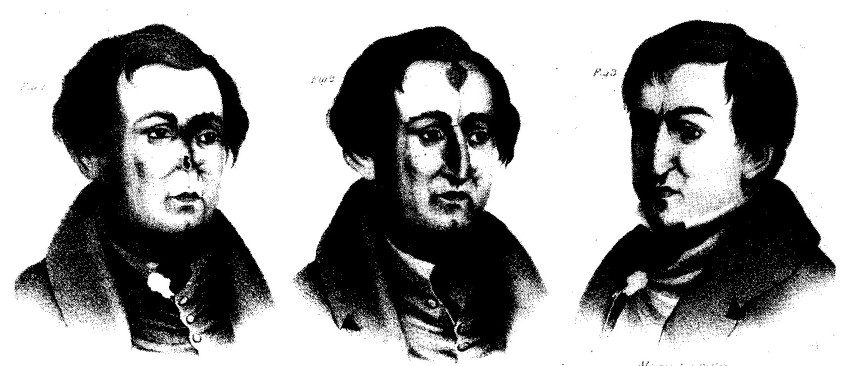Birju Rao
Chicago, Illinois, United States
 |
| Rhinoplastic operation J. Warren, The Boston Medical and Surgical Journal, 61:69, 1832 |
England in the early 1800s was experiencing a renaissance in medicine. The public’s perception of medicine had shifted from what was thought to be a mystic art form towards the understanding that it was indeed a logical, systematic science. During this time, Joseph Constantine Carpue had gained quite a reputation as a skilled surgeon while at the Duke of York’s Hospital in Chelsea. Outside of the operating room, he was admired as a charismatic lecturer, and held daily anatomy classes for 20 guineas. These classes were routinely overflowing with both students and laypeople. It is through these classes that Carpue became friends with Sir Joseph Banks, President of the Royal Society. One night the two friends were discussing a particularly unique case that Carpue had seen the previous day. Carpue described a Captain Williamson of the 30th division of Her Majesty’s Armed Forces who had lost his nose to what he was convinced to be mercury poisoning. For many years, Carpue had postulated the possibility of a nasal reconstruction procedure (rhinoplasty); however, he wasn’t quite sure how to proceed. Several days later and rather serendipitously, some news documents from the then British colony of India passed across Sir Joseph’s desk. As he looked through these documents, he discovered a story which described how a local village surgeon performing radical rhinoplastic reconstruction on a village dweller. Sir Joseph was shocked. On further investigation he discovered that the technique involved using a flap of skin taken from the forehead to produce the external tissue of the nose. Not only that, but the procedure had been perfected centuries earlier.
The first record of nasal reconstruction in Indian history is recorded circa 1500 BC in the epic poem Ramayana, where the evil King Ravana arranged for surgeons to reconstruct his sister Surpunkha’s nose after it was cut off by the hero Lakshaman.1 Historically, a common penalty for crimes in India was amputation of the nose. Thus, there emerged a substantial demand to develop methods for nasal reconstruction. Sir Joseph arranged to send these notes to Carpue. Several months later after careful studying the century old Indian technique, Carpue performed his first successful rhinoplasty. Carpue’s success was published and around the world the procedure came to be called “Carpue’s Operation.”2
Of course, the point of Carpue’s story is not one of plagiarism. Much later, Carpue did give credit to India for using their technique (though some say he was not upfront about it from the beginning). The point is that India had perfected a complicated surgical technique hundreds of years ago, unbeknownst to the rest of the world. As a collective scientific community, we all lost something when this knowledge wasn’t properly disseminated. If Einstein had left his scribbles on Special Relativity on his desk, unpublished, the clock of scientific progress would have been set back by decades—at the very least. In an era of peer-reviewed journals and Pubmed, it is hard to fathom a time when the medical knowledge waxed and waned with the rise and fall of civilizations. However, medicine has its roots in a very ancient history, and for most of that history, systematic dissemination of information was not a priority, especially in non-western societies. For this reason, anthropologists and historians are continually discovering that many ancient societies had a fairly sophisticated understanding of medicine.
From the Dead Sea scrolls to Fermat’s last theorem to Library of Alexandria, the list of treasured knowledge lost to time is seemingly endless. Perhaps, if properly retained and transmitted, the knowledge and ideas lost in these artifacts could have changed the course of history.
Even today, there is a similar struggle in which the research literature has a strong bias towards findings in the industrialized Western world. The large majority of the research that makes it into well-read journals takes place in America and Western Europe. To a large extent, many are still blind to scientific work that is done in “less industrialized” countries. Maybe the case of the Indian rhinoplasty can be blamed on the lack of a proper infrastructure through which information can be easily and quickly disseminated. However, if a finding of this caliber today is missed today, the blame can only be placed on the Western world’s arrogance and continued belief that research in the East is simply smoke and mirrors.
References
- Almast, S.: History and evolution of the Indian method of rhinoplasty. In Sanvenero-Rosselli, G. (ed.): Transactions of the fourth international congress of plastic and reconstructive surgery. Rome, 1969. Amsterdam, Excerpta Medica Foundation, 1969.
- Freshwater et al. Joseph Constantine Carpue—first military plastic surgeon. Military Medicine, August 1977.
BIRJU RAO, BA, is medical student at the University of Illinois at Chicago interested in understanding coordination within health systems. Before entering medical school, he earned a degree in Economics from Northwestern University.

Leave a Reply